For those who have noticed Wyoming’s pronghorn — aka antelope — running wildly back and forth lately, they’re not doing that for exercise, it's part of their mating ritual.
It’s the rut, or mating season, for antelope, that usually runs from late August to early October. And during that period, bucks will gather up groups of does, or harems, and fiercely guard them.
Busy Bucks
The bucks are insanely busy. When they’re not trying to fight off rival males, they have to keep an eye out for does that try to split and dash away from their harems.
Pinedale-area resident Jay Norman loves watching and photographing pronghorn. He recently caught a photo of a buck that had built a harem of more than a dozen does near a road.
A lucky buck indeed. Or is he?
That amorous pronghorn has his work cut out for him, Norman said.
“It is a lot harder to keep a group of that size together," he said.
Ladies’ Choice
A common assumption is that the biggest bucks, judged by the sheer size of their horns, will get the most does.
That might not be the case, retired Wyoming Game and Fish biologist and pronghorn aficionado Rich Guenzel told Cowboy State Daily.
Horn size can be deceptive when judged by the human eye, he said.
That’s because the size of bucks’ ears can vary. So a buck with smaller ears might appear to have horns that are longer than they really are, he said.
Moreover, pronghorn does might be looking for other markers of good genetics, not just big horns, he added.
“Bucks will do things like broadside displays to show it (body mass) to does,” he said.
In many cases, “the females are the ones who actually chose who they are going to breed with,” he said.
When a pronghorn buck is busy rounding up does, or trying to keep them in his harem, he’ll often have to crank it up to full speed to get ahead of the does.
Then, not unlike a sheep dog, he’ll try turning the does in the direction he wants them to go.
Guenzel said when a doe breaks from a harem and makes a dash for it, it might not be so much that she’s trying to get away as to test her potential mate’s speed and agility.
It also could be that she already had another boyfriend in mind.
“She’s trying to go find the one she wants to breed with,” he said.
Good Pals Until The Rut Starts
Most of the year, pronghorn bucks get along well with each other.
Younger bucks will form up “bachelor herds” during the summer and sometimes engage in some friendly sparring, Guenzel said.
When the rut hits, things get less amicable.
Norman said he’s seen it happen among the pronghorn herd that hangs out practically outside the front door of his rural property.
“You’ll see the bucks all hanging out in a field together. Then when the rut starts, it’s like a switch goes off in their heads,” he said.
Suddenly, nobody wants to be friends. Bucks will start wandering about trying to round up does — or steal does away from another buck’s harem.
Usually, dominant bucks can just run their rivals off. But sometimes it comes down to fighting, Norman said.
When that happens, “They can get brutal with each other,” he said.
Guenzel said that bouts between pronghorn bucks can get pitched, but rarely result in injuries.
Survival Is The Goal
As the rut winds down, bucks that might not have been able to snag big harems might still get a chance to mate as the groups disperse, Guenzel said.
As science has improved, genetic studies have revealed that some twin pronghorn fawns each have different sires, he said.
“Twins with different dads don’t occur in some species, but they do occur in pronghorn,” he said.
“We like to make up nice, neat stories of how things work. Sometimes those rules apply, but they’re not as hard and fast as they’re sometimes portrayed,” he added.
Pronghorn have a long gestation period, roughly 250 days, he said.
The rut wraps up by mid-October in Wyoming. For pronghorn herds farther south in places like Arizona, it might go on much longer, he said.
Wyoming pronghorns end the breeding season earlier, because they’re trying to hit the ideal date for birthing fawns, usually in late May or early June, he said.
“For pronghorn in Wyoming, they’re trying to drop their fawns when they’ll have the best chance for survival,” he said.
Mark Heinz can be reached at mark@cowboystatedaily.com.










